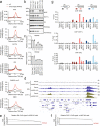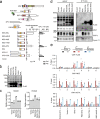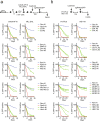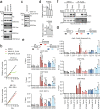MOZ/ENL complex is a recruiting factor of leukemic AF10 fusion proteins
- PMID: 37031220
- PMCID: PMC10082848
- DOI: 10.1038/s41467-023-37712-5
MOZ/ENL complex is a recruiting factor of leukemic AF10 fusion proteins
Abstract
Changes in the transcriptional machinery cause aberrant self-renewal of non-stem hematopoietic progenitors. AF10 fusions, such as CALM-AF10, are generated via chromosomal translocations, causing malignant leukemia. In this study, we demonstrate that AF10 fusion proteins cause aberrant self-renewal via ENL, which binds to MOZ/MORF lysine acetyltransferases (KATs). The interaction of ENL with MOZ, via its YEATS domain, is critical for CALM-AF10-mediated leukemic transformation. The MOZ/ENL complex recruits DOT1L/AF10 fusion complexes and maintains their chromatin retention via KAT activity. Therefore, inhibitors of MOZ/MORF KATs directly suppress the functions of AF10 fusion proteins, thereby exhibiting strong antitumor effects on AF10 translocation-induced leukemia. Combinatorial inhibition of MOZ/MORF and DOT1L cooperatively induces differentiation of CALM-AF10-leukemia cells. These results reveal roles for the MOZ/ENL complex as an essential recruiting factor of the AF10 fusion/DOT1L complex, providing a rationale for using MOZ/MORF KAT inhibitors in AF10 translocation-induced leukemia.
© 2023. The Author(s).
Conflict of interest statement
A.Y. received a research grant from Sumitomo Pharma Co. Ltd. The remaining authors declare no competing interests.
Figures









Similar articles
-
The YEATS domain epigenetic reader proteins ENL and AF9 and their therapeutic value in leukemia.Exp Hematol. 2023 Aug;124:15-21. doi: 10.1016/j.exphem.2023.06.001. Epub 2023 Jun 7. Exp Hematol. 2023. PMID: 37295550 Free PMC article. Review.
-
Activation of CpG-Rich Promoters Mediated by MLL Drives MOZ-Rearranged Leukemia.Cell Rep. 2020 Sep 29;32(13):108200. doi: 10.1016/j.celrep.2020.108200. Cell Rep. 2020. PMID: 32997997
-
Abrogation of MLL-AF10 and CALM-AF10-mediated transformation through genetic inactivation or pharmacological inhibition of the H3K79 methyltransferase Dot1l.Leukemia. 2013 Apr;27(4):813-22. doi: 10.1038/leu.2012.327. Epub 2012 Nov 9. Leukemia. 2013. PMID: 23138183 Free PMC article.
-
Tip60 activates Hoxa9 and Meis1 expression through acetylation of H2A.Z, promoting MLL-AF10 and MLL-ENL acute myeloid leukemia.Leukemia. 2021 Oct;35(10):2840-2853. doi: 10.1038/s41375-021-01244-y. Epub 2021 May 9. Leukemia. 2021. PMID: 33967269
-
The role of CALM-AF10 gene fusion in acute leukemia.Leukemia. 2008 Apr;22(4):678-85. doi: 10.1038/sj.leu.2405074. Epub 2007 Dec 20. Leukemia. 2008. PMID: 18094714 Free PMC article. Review.
Cited by
-
Structural variants involving MLLT10 fusion are associated with adverse outcomes in pediatric acute myeloid leukemia.Blood Adv. 2024 Apr 23;8(8):2005-2017. doi: 10.1182/bloodadvances.2023010805. Blood Adv. 2024. PMID: 38306602 Free PMC article.
-
The YEATS domain epigenetic reader proteins ENL and AF9 and their therapeutic value in leukemia.Exp Hematol. 2023 Aug;124:15-21. doi: 10.1016/j.exphem.2023.06.001. Epub 2023 Jun 7. Exp Hematol. 2023. PMID: 37295550 Free PMC article. Review.
-
A multivalent engagement of ENL with MOZ.Nat Struct Mol Biol. 2025 Apr;32(4):709-718. doi: 10.1038/s41594-024-01455-8. Epub 2025 Jan 10. Nat Struct Mol Biol. 2025. PMID: 39794553
-
Unveiling the role of GAS41 in cancer progression.Cancer Cell Int. 2023 Oct 18;23(1):245. doi: 10.1186/s12935-023-03098-z. Cancer Cell Int. 2023. PMID: 37853482 Free PMC article. Review.
-
HBO1, a MYSTerious KAT and its links to cancer.Biochim Biophys Acta Gene Regul Mech. 2024 Sep;1867(3):195045. doi: 10.1016/j.bbagrm.2024.195045. Epub 2024 Jun 6. Biochim Biophys Acta Gene Regul Mech. 2024. PMID: 38851533 Free PMC article. Review.
References
Publication types
MeSH terms
Substances
LinkOut - more resources
Full Text Sources
Medical

